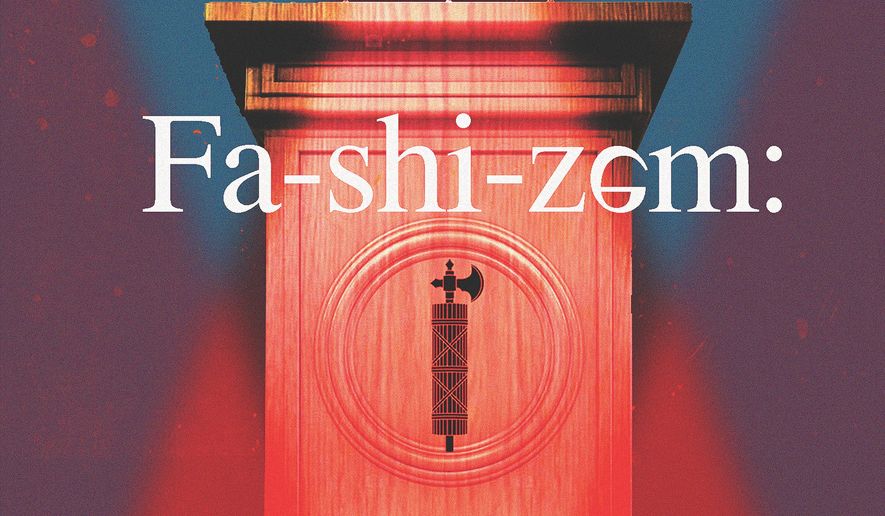OPINION:
Fascism seems to be all the rage these days. I’ll give you a few examples.
Ben Rhodes, who was President Barack Obama’s deputy national security advisor for strategic communications (a title suggesting foreign policy with a spin), wrote last year that the presidency of Donald Trump was “an American experiment with fascism.”
Democratic National Committee chairman Jaime Harrison echoed him, declaring that the Republican Party has “become a party of fascism and fear.”
Actor/activist Rob Reiner tweeted last week: “This Midterm there is no gray area. You either cast a vote for Democracy or Fascism. That’s it.”
And, of course, President Joe Biden recently charged that Republicans – many if not all – embrace “semi-fascism.”
Was he using that modifier to imply that there are a few tenets of fascism not endorsed even by the “MAGA Republicans” he so intensely despises? Since the most lethal variety of fascism is Nazism, he at least might have made clear that he’s not calling his political opponents genocidal.
My guess is that Mr. Biden, like others employing the term, knows little about this revolutionary ideology to which millions of people in Germany, Italy, Japan, and other countries adhered during the first half of the 20th century.
If you were so daring as to pull aside a black-shirted Antifa member during one of the street riots that group has initiated and ask for a definition of the “fa” he thinks he’s combatting, do you think you’d get a coherent answer?
Would he know that members of the paramilitary wing of Benito Mussolini’s National Fascist Party also wore and were called Blackshirts, and that a similarly violent wing of the Nazi Party wore and were called Brownshirts?
Expressions of fascist fashion – or, more properly, of the “Fascist Aesthetic” – were even more elaborately on display when Mr. Biden recently let loose a diatribe in front of Philadelphia’s Independence Hall, its walls bathed in bloodred lights, U.S. Marines menacingly backing him up.
The president directed his fury toward those millions of fellow Americans he regards as enemies of the state and its leader. “Donald Trump and the MAGA Republicans,” he railed, “represent an extremism that threatens the very foundations of our republic!”
Did the White House communications team – whom I presume wrote the speech and designed the “optics” – realize they were drawing on fascist imagery when they cast the president as a strongman, an idolized and militaristic authority figure differentiating between pure and impure, and determined to crush those who, as Mr. Biden put it, “do not recognize the will of the people”?
Perhaps the president’s advisors thought: “Hey, our job is to make the midterm elections a referendum not on Biden and his record, but on Trump and any Republicans who have not publicly rejected him. So, whatever it takes – even if fascist-inspired.”
Consistent with this strategy, Mr. Biden’s supporters have spent more than $40 million to boost the most Trumpian MAGA Republicans in primaries around the country so that Democrats can run against candidates they believe will be easier to defeat in the general elections.
As Nora Ephron used to say: “No matter how cynical I get, I just can’t keep up.”
Okay, class, now take your seats because it’s time for Fascism 101. Among the best scholarly books on the subject remains Eugen Weber’s “Varieties of Fascism: Doctrines of Revolution in the Twentieth Century,” first published in 1964.
Fascism, Nazism and other “national socialisms,” he writes, “had their roots in the 19th century and even earlier” in ideas promulgated by such philosophers as Rousseau, Hegel, and Nietzsche.
The term derives from fascio, Italian for a bundle or sheath, conveying “strength through unity,” the unifying force being the government and its supreme leader. As Mussolini put it: “Everything within the state, nothing outside the state, nothing against the state.”
In common with communism, fascism in its diverse forms opposes liberalism, defined as “individualism and the apparently chaotic conclusions of private enterprise.”
Also akin to communism, fascism has had a “passion for science” that often turns out to be pseudo-science. The Soviet Communists had Lysenkoism. Nazis believed, as Nazi ideologue Alfred Rosenberg wrote, that “history must be judged from the point of view of race.”
The poet Ezra Pound, a well-known American fascist, moved to Italy in 1924 where he wrote for publications owned by the British fascist Oswald Moseley (whose streetfighters also were called Blackshirts). Pound supported Hitler’s rise, including in paid radio broadcasts attacking the U.S., the U.K., Roosevelt, Churchill, and Jews. Among the ideas he championed: “race pride.”
As George Mosse notes in “Fascist Aesthetics and Society: Some Considerations,” the “human body indicates the structure of the mind.”
Another attribute of fascism is hyper-nationalism. The Axis powers all invaded neighbors and folded them into their expanding empires.
Neither Mr. Trump nor Mr. Biden has displayed any interest in foreign conquests, as far as I’m aware. On the contrary, I see too many Republicans and Democrats succumbing to the siren song of isolationism.
This is an opinion column and I’ll close with this one: A serious argument can be made that Vladimir Putin, Xi Jinping, Ali Khamenei, and Kim Jong-un exemplify 21st century varieties of fascism. Had Mr. Biden addressed the increasing national security threats they pose, he might have helped unite us against those who hate us – Democrats and Republicans, progressives and conservatives, the woke and the unwoke. He chose not to.
I think that’s because he wants to win in the worst way. And it’s hard to imagine any way worse than this: slandering his political opponents as fascists while posing as a modern Mussolini in the City of Brotherly Love.
• Clifford D. May is founder and president of the Foundation for Defense of Democracies (FDD) and a columnist for the Washington Times.




Please read our comment policy before commenting.